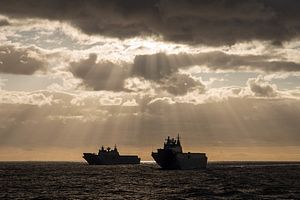Australia is continuing its recent trajectory towards developing a more robust defense architecture. Not only has the country significantly increased its defense expenditure, and has begun acquiring major new hardware, this week saw the government release an aspirational new Defense Export Strategy that hopes to move Australia in to the top 10 defense product exporting countries by 2028.
Currently, the country’s defense exports amount to 0.3 percent share of the global market — $1.6 billion per annum — making it the 20th largest arms exporter. The government is hoping that by establishing a $3.1 billion fund that will provide loans to local defense industry manufacturers to expand their businesses, they will be able to find new export markets, and rapidly increase Australia’s share of the market.
The plan seems wildly ambitious as countries in the lower half of the top 10 exporters (Spain, Italy, Ukraine and Israel) each have over eight times the worth of exports. However, Australia seems to have identified an area of manufacturing that should continue to grow as other manufacturing industries decline or become locally unviable, and it hopes that the country can develop the necessary skills to take advantage of the demand. Australia itself doesn’t have the military capacity to sustain a domestic industry with its own needs. But the government has indicated it would focus on complimentary hardware for its Five Eyes allies in the United States, United Kingdom, Canada and New Zealand, as well as targeting markets in Asia and the Middle East.
The government has stated that as Australia’s export capabilities increase it will have measures in place to prevent the sale of hardware into conflict zones or to countries with poor human rights records. Yet according to a report by the Stockholm International Peace Research Institute, Indonesia is currently Australia’s second largest importer of defense equipment (after the United States) at around 21 percent of Australian exports, and concerns remain about the behavior of the Indonesian military (TNI) in West Papua. While ever-closer ties with Indonesia are vital to Australian security, and greater arms sales may assist with this process, a greater consolidation of defense sales to Indonesia would be of particular concern to Australia’s Melanesian neighbors, who remain strong advocates for West Papuan rights.
While the uncertainty brought by shifting regional power structures in the Indo-Pacific may be a major driver of Australia’s desire to enhance its defence capabilities, domestic regional economic shifts are also a significant factor. With the state of South Australia (SA) struggling with the viability of a number of manufacturing industries, it is seeking to become the hub of Australia’s defence aspirations in an attempt to revitalize the state’s fortunes.
With the last car manufacturing plant in Australia closing in the state capital of Adelaide in October last year, the country has also lost a strategic heavy manufacturing capability should it find itself in need to convert civilian operations into large-scale military production. The government seems to be attempting to pivot this civilian loss directly into a greater defense capability. Hoping that the “high end” value of this industry will be of greater and more stable financial benefit to the region, as well as a national strategic gain.
However, the new scheme has posed the question of whether Australian defense manufacturers actually require public funding to boost their operations, when opportunities for finance would exist in the private sector. Although the government may be using the high profile announcement to encourage defense manufacturers to heighten their ambitions. And the potential for civil society groups opposed to financial institutions lending to defense manufacturers gaining public traction could also have been a factor.
Despite this, because the market for large scale defense hardware — warships, planes, submarines — is already dominated by the United States, Russia and European Union countries, it is unlikely Australia will develop the capacity and expertise to shift the market in any significant way within a decade. It is also unlikely that Australia could be competitive on cost either. The development of niche innovations that can be complementary to the hardware of major global defense manufacturers is most likely what the government envisages.
The implications of the government’s proposal is that it sees some potential growth and profitability in the future of Australia’s defense industry. At the very least, the desire to develop a viable high-end defense manufacturing capability is an indication that Australia is seeking to create a more self-sufficient and muscular defense infrastructure. One that is less reliant on other powers and a little more strategic flexibility.
































